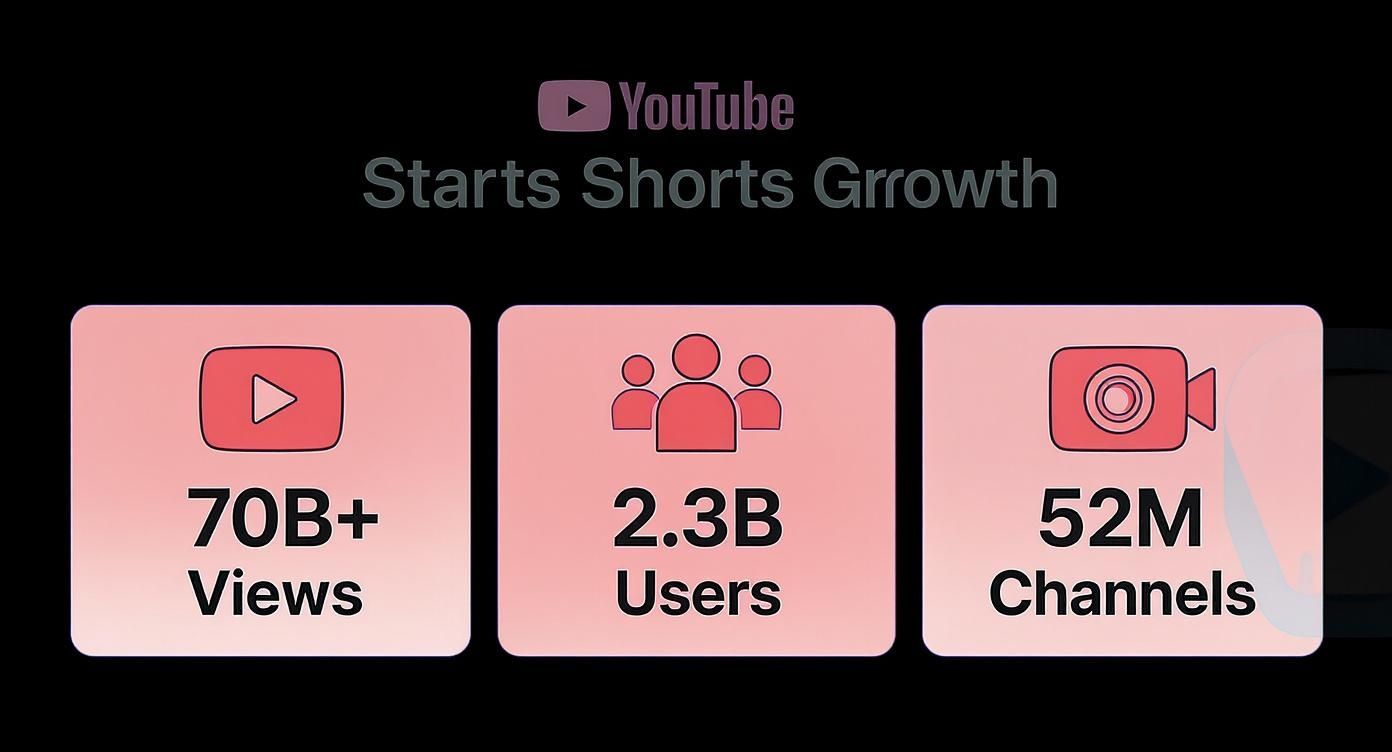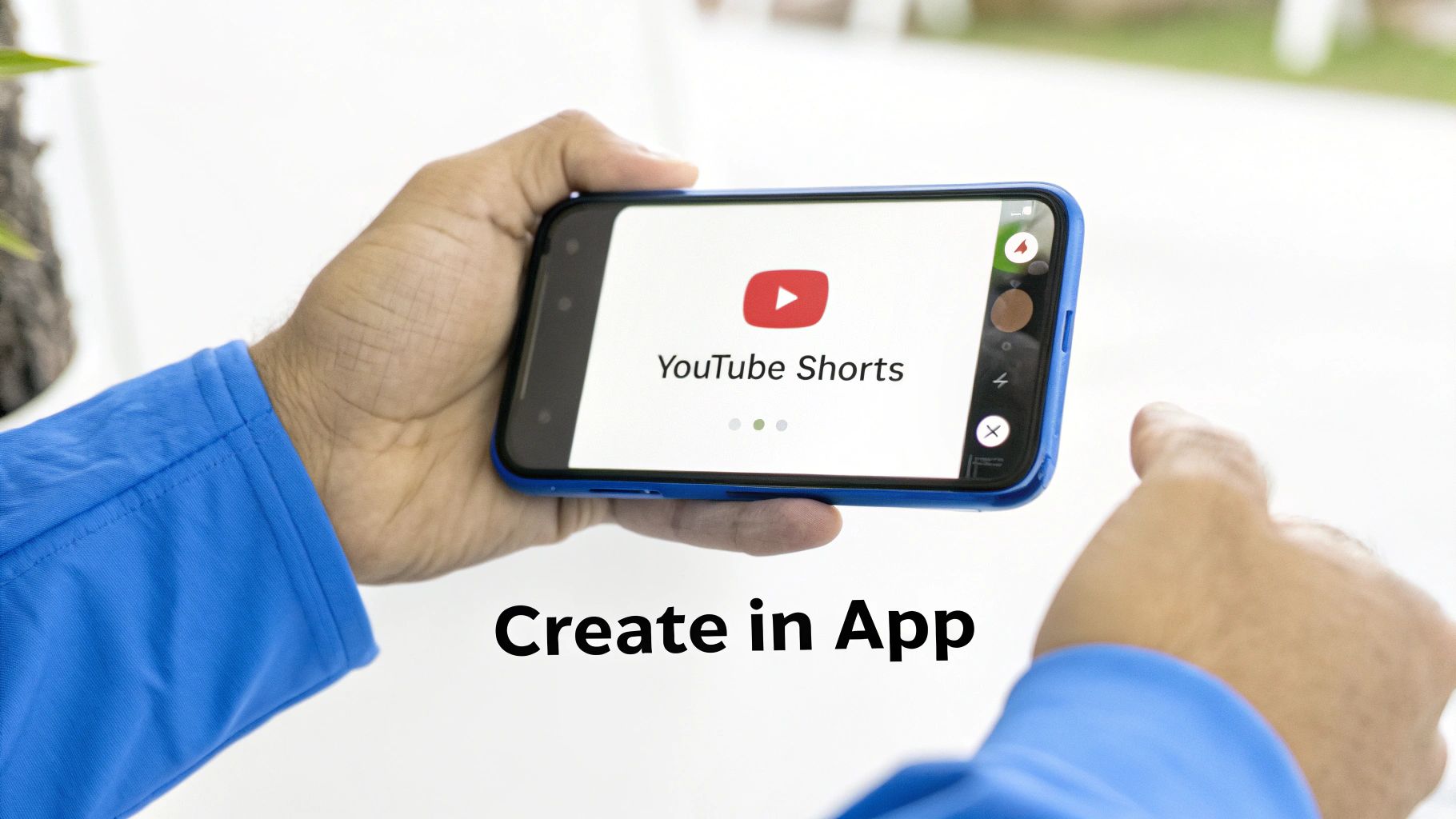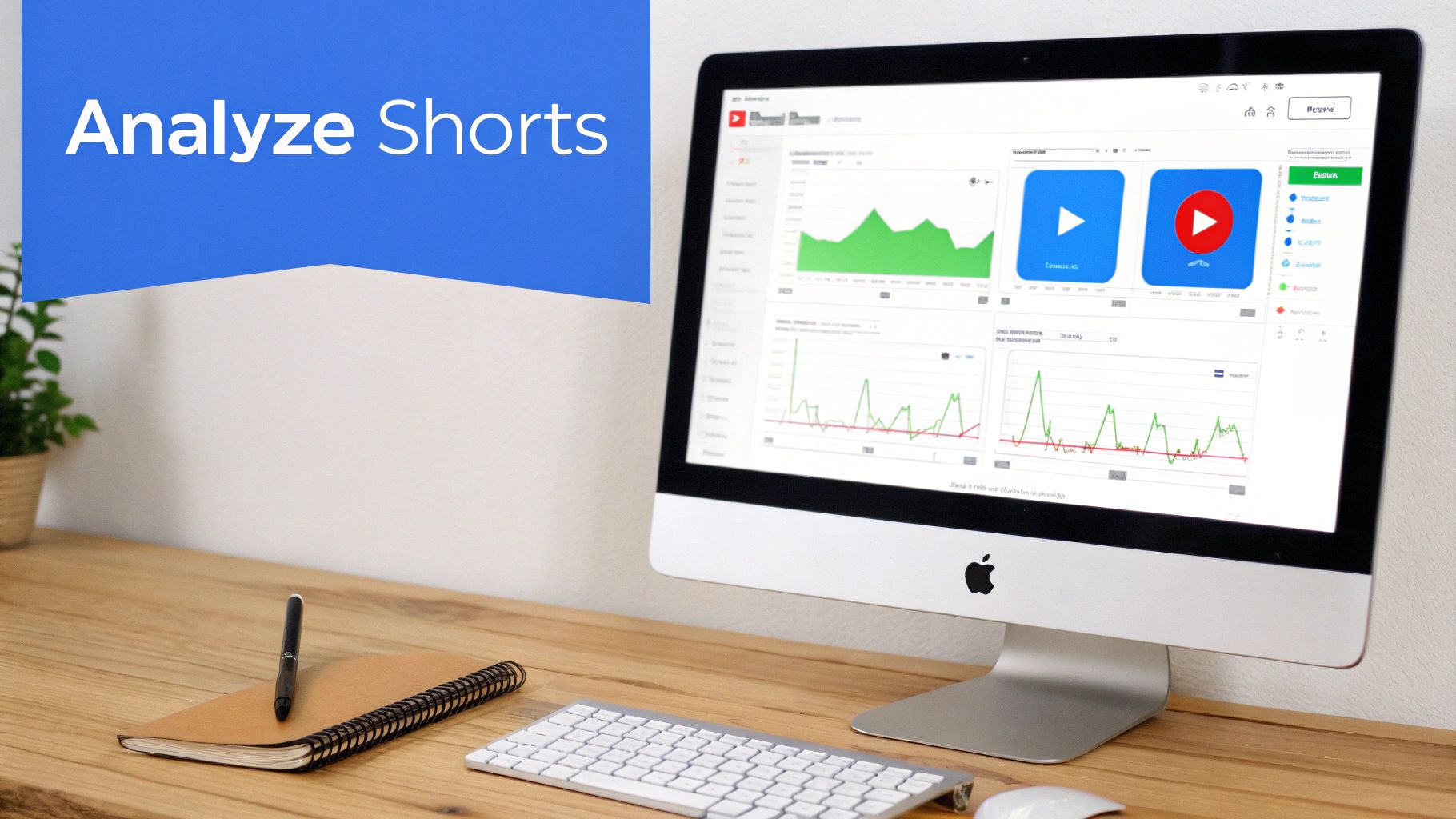Posting a YouTube Short is deceptively simple: grab your phone, upload a vertical video under 60 seconds, slap on a title with the #shorts hashtag, and hit publish. But don't let the simplicity fool you. This format is an absolute powerhouse for getting your channel noticed.
Why YouTube Shorts Are Essential For Growth
This isn't just about jumping on a trend. It’s about leveraging an algorithm that’s practically built to put new channels on the map. Shorts give fresh creators a real shot at visibility and help established channels break out of their bubble to find totally new viewers.
Think of it this way: learning how to create great Shorts is a direct investment in your channel’s future.
Google launched Shorts back in 2020 to compete with TikTok, and its growth has been nothing short of explosive. Fast forward to 2025, and over 52 million channels have uploaded Shorts—that’s a massive 50% jump in creators using the format year-over-year. The platform is pulling in around 2.3 billion monthly users, with daily views skyrocketing past an incredible 70 billion. You can find even more stats on the rise of Shorts over at Voomo.ai.
These numbers paint a crystal-clear picture of just how massive Shorts have become.

It's settled. Shorts aren't some fleeting feature; they're a core part of the YouTube experience for both creators and viewers.
The Strategic Advantage of Shorts
So, what’s in it for you? Posting Shorts gives you a few key advantages that you just can't get with traditional long-form videos.
- Algorithmic Discovery: The Shorts feed is a discovery engine. Your content can get pushed to millions of people who have never heard of you, creating a direct pipeline to new subscribers.
- Rapid Content Production: A polished, 15-minute video can take days of work. A high-impact Short? You can knock that out in under an hour. This lets you post more often and experiment without a huge time commitment.
- Lower Barrier to Entry: You don’t need fancy gear. Your smartphone and a solid idea are all it takes to start creating content that can compete with the big channels.
The real power of Shorts is that they’re a low-risk, high-reward testing ground. You can quickly throw new ideas, content styles, and topics at the wall to see what sticks with a massive audience before you sink tons of effort into a longer video.
Creating Your First Short Inside the YouTube App
Let's walk through creating your first Short right from your phone. Honestly, the fastest way to get your feet wet is by using the YouTube app itself. It has a surprisingly solid set of tools built right in, making it perfect for creating content on the fly without a bunch of complicated software.
Everything you need is already in your pocket. Just open the YouTube app, tap that big plus icon (+) at the bottom, and choose “Create a Short.” This drops you straight into the Shorts camera, which is basically your command center for filming and editing.
Recording and Basic Tools
The simplest way to start is to just press and hold the red record button to capture your video. But what if you need your hands free? That’s where the timer comes in. You can set a countdown, prop your phone up, and let it start recording automatically. It’s a lifesaver for filming yourself doing something or getting that perfect behind-the-scenes shot without needing a camera person.
You can also string multiple clips together to build a more dynamic video. Film a bit, stop, switch your angle or what you're showing, and then record another piece. YouTube automatically stitches them together for you. This is how so many creators build a whole story without ever leaving the app.
The real beauty of the in-app tools is the speed. You can go from a cool idea to a published Short in less than ten minutes. This makes it super easy to just try things out and see what your audience actually likes.
Adding Music and Visuals
Once your clips are recorded, it’s time for the fun part—adding the personality that makes a Short pop. At the top of the screen, you'll see an “Add sound” button. This is your gateway to YouTube’s huge library of licensed music and, more importantly, trending audio. Hopping on a popular sound can give your Short a massive visibility boost because the algorithm loves to push videos using trending audio.
Beyond the sound, you’ve got a few other key tools to play with:
- Filters: Quickly apply a color grade to shift the mood of your video.
- Text: Add captions or bold callouts to make your points stand out. You can even change up the fonts and colors.
- Timeline: This lets you fine-tune exactly when your text appears and disappears, which is great for pacing and emphasis.
At the end of the day, the foundation of a great Short is knowing how to create engaging content that hooks people immediately. While these built-in tools are fantastic for getting started, you might eventually want more control. When you're ready for that, our guide on how to edit YouTube Shorts dives into third-party apps and more advanced editing tricks.
Uploading and Optimizing Your Short for Discovery
Creating a great video is only half the battle. If nobody sees it, all that effort goes to waste. Once your Short is edited and ready, the next step is arguably the most important: telling the YouTube algorithm what your content is about and who needs to see it.
This is where you shift from being a creator to a strategist.

Your title is everything. It's your first—and maybe only—chance to grab someone's attention in a fast-moving feed. Think like a viewer who’s endlessly scrolling. What would make them pause? Instead of a flat title like "My New Recipe," go for something irresistible like "2-Minute Viral Feta Pasta Hack." See the difference?
Here’s the most critical part: you must include #shorts in either your title or description. While YouTube is pretty good at automatically detecting Shorts, adding this hashtag is your insurance policy. It guarantees your video gets properly indexed and pushed into the Shorts feed, which is exactly where you want to be.
Crafting the Perfect Details
After nailing the title, turn your attention to the description. Sure, most viewers probably won't click to read it, but the algorithm absolutely will. This is your chance to feed it relevant keywords. For that pasta hack video, you'd want to include phrases like "quick dinner ideas," "easy pasta recipe," and "tiktok feta pasta."
Toss in two or three extra hashtags here, too—something like #easyrecipes or #foodhacks can help you cast a wider net.
Next up are your visibility settings. This feels like a simple choice, but it’s more strategic than it looks.
- Public: Your Short goes live for the world to see, right now.
- Unlisted: Perfect for getting a second opinion. Only people with the link can see it, so you can send it to a friend for feedback before the big reveal.
- Private: This one's just for you. Nobody else can see it.
- Schedule: This is the pro move. You can upload your video and set a specific date and time for it to go public.
Scheduling is an absolute game-changer for staying consistent. It lets you batch-create your content for the week and keep a steady posting rhythm without having to manually upload every single day.
Finally, don't sleep on the thumbnail. Even though Shorts autoplay in the feed, the thumbnail you select shows up on your channel page and in search results. Just scroll through your video and pick a clear, dynamic frame that really pops. It’s your tiny billboard.
For a deeper dive into timing your posts for maximum impact, check out our guide on the best times to post on YouTube Shorts in 2025. Every bit of optimization helps you stand out in a sea of 1.5 billion daily Shorts uploads.
Advanced Tactics to Boost Your Shorts Performance

If you're already creating long-form videos, you're sitting on a goldmine for Shorts. Think of repurposing those longer videos as trailers. It’s a killer way to give your main content fresh exposure.
By slicing out the most compelling moments from your latest tutorial or vlog, you create irresistible curiosity hooks. These little teasers can drive a surprising amount of traffic back to the full video. Best of all? You’re leveraging existing assets without any extra shooting time.
But don't just chop up a clip and call it a day. The key is to refine that clip into its own self-contained, satisfying narrative. For example, you could highlight a moment of high drama or quickly reveal a game-changing tip. The goal is to keep the energy high and transitions smooth to lock in that retention.
I once turned a 5-minute tutorial into a 30-second highlight reel. The result? A 20% jump in engagement on the full video within a single week. It works.
Perfect Loop Techniques
Want to trick viewers into watching your Short twice (or more)? Master the perfect loop. When a Short’s ending flows seamlessly back into its beginning, it can skyrocket your view count. This signals strong retention to the algorithm, and with 70–90 billion daily views on the platform, that's a signal you want to send.
For the best effect, keep the loopable segment under three seconds. This makes the replay feel almost instantaneous and completely natural.
A perfect loop can increase watch time by up to 15%, sending strong signals to the algorithm.
Strategic Audio Selection
Jumping on a trending audio track is smart, but it doesn't mean you have to sacrifice your brand's voice. The trick is to blend popular sounds with your own unique twist.
Think about layering a trending track with a custom spoken tagline or a unique musical riff that’s all your own. This gives you the best of both worlds: discoverability and brand identity.
- Highlight trending hooks, but always add a branded phrase over the top.
- Make sure the energy of the sound matches the energy of your clip so it feels cohesive.
- Get in the habit of exploring trending audio playlists weekly to stay current.
Engagement Metrics and Growth
Shifting your focus to the right metrics is what separates the pros from the amateurs. The growth of Shorts has been explosive. Back in 2021, Shorts were pulling in 30 billion daily views. That number jumped to 50 billion by early 2022.
Fast forward to 2025, and daily views have surged to between 70–90 billion. That’s more than double in just four years. Even more impressive, the average engagement rate for Shorts is a massive 5.91%, which consistently outpaces both TikTok and Reels.
Crafting a Scroll-Stopping Hook
You have about two seconds to stop someone from scrolling past your Short. A strong opening isn't just nice to have; it's essential. Ask a provocative question, tease a big payoff, or flash a surprising visual right at the start.
Here's how to craft a hook that works:
- Lead immediately with action, conflict, or tension.
- Use bold text overlays to make your opening promise crystal clear.
- Pair your hook with a thumbnail frame that’s impossible to ignore.
And if you really want to maximize your channel's potential, integrating a solid monetization strategy is the next logical step. A great place to start is by learning more about starting affiliate marketing on YouTube.
Using Analytics to Refine Your Shorts Strategy
Throwing Shorts at the wall and hoping something sticks is a recipe for burnout. The real secret to consistent growth? Digging into your YouTube Studio analytics. This is where you stop guessing and start making data-driven decisions about what your audience actually wants to see.
Think of it as your roadmap. Instead of wondering why a Short flopped, your analytics will tell you exactly where viewers lost interest. The goal is to figure out which clips capture attention and which ones just don't land.
Key Metrics to Monitor
First thing's first: you need to know where your views are coming from. Jump into your Reach report and filter specifically for the Shorts feed. This is the single most important traffic source for Shorts, so focusing on content that performs well here is crucial.
Once you're there, keep an eye on a few key numbers:
- Traffic Sources: See what percentage of your views originate from the Shorts feed compared to other places like channel pages or search. A high number here is a great sign.
- Audience Retention: This graph is pure gold. It shows you, second by second, where people are dropping off within that tight 60-second window.
- Subscriber Conversions: Are your Shorts just getting passive views, or are they actually convincing people to hit that subscribe button? This metric tells you which videos are true growth drivers.
Don't forget to check your demographic stats, either. Seeing a sudden spike in viewers from a new country can be a lightbulb moment, giving you ideas for Shorts with localized hooks or references.
Interpreting Retention Patterns
Your audience retention graph is more than just a line; it tells a story. Look for any sharp spikes or flat plateaus—these are the moments that truly resonated with viewers.
For instance, did you notice a big chunk of your audience stuck around after a quick jump scare at the 5-second mark? That's a powerful hook. Try replicating that style of opening in your next few Shorts and see if the pattern holds.
"Data doesn’t lie: a clear retention boost often predicts subscriber growth."
When you're testing new ideas, don't just rely on memory. Set up a simple table to track your "wild card" Shorts side-by-side. This makes it so much easier to visually compare their performance and isolate what single change might have made all the difference.
To take your analytics game even further, check out our deep dive into the most important numbers for your channel's success.
Learn more about key metrics in our article on Shorts growth metrics.
Got Questions About Posting YouTube Shorts?

Even with a solid plan, a few questions always seem to pop up when creators are getting the hang of posting YouTube Shorts. Let's clear the air so you can upload with total confidence.
One of the biggest hang-ups is video length. You get up to 60 seconds, but is shorter actually better? Honestly, it all comes down to your content. The perfect length is however long it takes you to land your hook and deliver the payoff without a single wasted second.
I also see a lot of people asking if they can just upload a horizontal video. While you technically can, it's a terrible idea. The Shorts player is designed for vertical video, and a horizontal clip just gets slapped with huge black bars, killing the viewing experience. Always, always stick to a vertical aspect ratio.
Can I Monetize My Shorts?
Absolutely! YouTube's Partner Program now covers Shorts monetization. It works a bit differently than long-form videos, though. Revenue from ads shown between Shorts gets pooled together, and then YouTube distributes it to eligible creators based on their slice of the total Shorts views pie.
So while you can't control the specific ads on your Shorts, it's still a clear path to earning. Just make sure you meet the standard Partner Program requirements to be eligible.
Quick tip: Since you can't pick the ads, your best bet for maximizing earnings is to focus on what you can control—cranking out high-engagement Shorts that rack up tons of views. That's how you get a bigger piece of the revenue pool.
And what about the #shorts hashtag? Is it still necessary? YouTube's algorithm is pretty smart now and can usually identify a Short on its own. That said, I still recommend using it. Think of it as a clear, unmistakable signal to the system that removes any doubt. It’s a simple best practice.
Ready to stop spending hours on a single Short? ShortsNinja uses AI to help you create and publish high-quality videos in just minutes. Input an idea, and let our platform script, generate visuals, and schedule your content, so your channel grows on autopilot. Start your free trial at ShortsNinja today!

